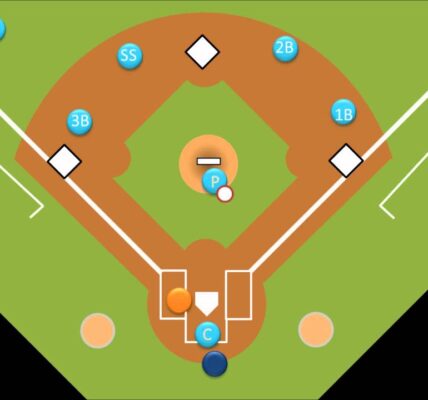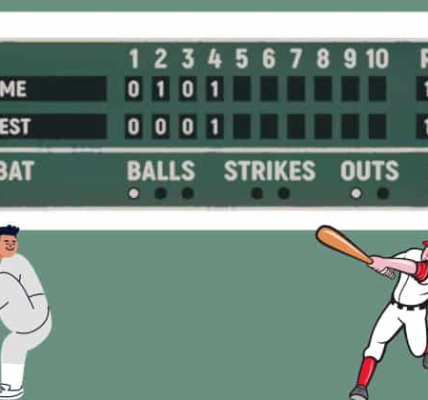Understanding the significance of batting average in baseball is akin to deciphering a player’s prowess at the plate. In this exploration, we’ll unravel the basics of this metric, delve into its calculation, and scrutinize its relevance in evaluating player performance. Beyond the numbers, we’ll uncover the intricacies that shape the narrative of batting averages, offering a comprehensive view of this fundamental statistic.
Batting Average Unveiled
At its core, batting average encapsulates a hitter’s success rate during an at-bat, calculated by dividing hits by total at-bats, excluding walks and other factors. This seemingly straightforward metric, one of baseball’s oldest, is a staple for enthusiasts, often grasped even by the youngest players on sandlots.
Batting average is a statistic used in baseball and cricket to measure a player’s success in hitting the ball. The calculation for batting average is slightly different in baseball and cricket.
Baseball Batting Average
In baseball, batting average is calculated as follows:
Batting Average (BA)=Hits (H)At Bats (AB)
Batting Average (BA)=
At Bats (AB)
Hits (H)
Here,
- Hits (H): The total number of times a player successfully reaches base after hitting the ball;
- At Bats (AB): The total number of official times a player bats, excluding walks, sacrifices, and times hit by a pitch.
The result is a decimal number typically expressed to three decimal places. For example, a batting average of .300 means that a player gets a hit approximately 30% of the time.
Cricket Batting Average
In cricket, batting average is calculated slightly differently:
Batting Average=Total RunsNumber of Dismissals
Batting Average=
Number of Dismissals
Total Runs
Here,
- Total Runs: The sum of all the runs scored by the batsman;
- Number of Dismissals: The total number of times the batsman gets out.
Similar to baseball, the batting average in cricket is expressed as a decimal. A higher batting average indicates better performance, as it signifies that the batsman scores more runs per dismissal.
Interpretation
In both baseball and cricket, a higher batting average is generally considered better, as it indicates that the player is more successful in making runs or hits:
- It’s important to note that batting average doesn’t take into account other factors such as the quality of opposition, match conditions, or the context of the game. Therefore, while it provides a useful measure of a player’s consistency, it doesn’t provide a complete picture of a player’s overall performance;
- In cricket, a batting average above 40 is often considered very good, while in baseball, a batting average of .300 or higher is considered excellent. However, these benchmarks can vary based on the level of play and historical context.
Overall, batting average is a fundamental statistic used to assess a player’s performance at the plate and is widely used in both baseball and cricket to evaluate a player’s batting prowess.
Decoding Batting Average
Essentially, batting average represents the percentage of at-bats where a hitter secures a hit. Fans employ it as a predictive tool, estimating a player’s likelihood of success at the plate. Yet, this average, fluctuating between 0 and 1.00, unveils a dynamic story—games where expectations are exceeded, others where they fall short, and those where expectations are met precisely.
Mathematics Behind the Plate
Calculating batting average boils down to basic math: hits divided by at-bats. A numerical outcome between 0 and 1.00 emerges, with a sweet spot in the modern era ranging from .240 to .250. While superstars may breach the .300 mark, lower leagues may witness elevated averages due to fewer games and potentially less competitive pitching.
Beyond the Numbers: Is Batting Average Enough?
While batting average is a reliable indicator of a player’s ability to make contact with the ball, it doesn’t tell the full tale. Factors like walks and situational hitting are omitted. Consequently, it might not reveal a player’s effectiveness in scoring or how they perform with runners on base.
MLB Averages Over Time
In recent years, Major League Baseball has seen batting averages oscillate between .240 and .250. The legendary Ty Cobb maintains a career record with a remarkable .366 average over 24 seasons, while Nap Lajoie set an unparalleled single-season mark of .426 in 1901.
FAQ
In baseball, the traditional batting average does not include walks (base on balls or BB) in its calculation. The formula for batting average is:
Batting Average (BA)=Hits (H)At Bats (AB)
Batting Average (BA)=
At Bats (AB)
Hits (H)
Hits (H) refers to the number of times a player successfully reaches base with a hit. At Bats (AB) includes only official times at bat and excludes walks, sacrifices, and times hit by a pitch. Walks are not considered as at-bats, so they do not factor into the batting average calculation.
That honor goes to Ty Cobb, the “Georgia Peach”! He boasted a career batting average of .366 over an impressive 24-season career, primarily with the Detroit Tigers.
It’s worth noting that while Cobb’s career average stands tall, the game has undoubtedly changed over the decades. Many argue that hitting a truly high average is more challenging in the modern era due to factors like improved pitching strategies and stricter enforcement of rules.
As of today, January 18, 2024, the MLB season is still months away from starting, so there’s no current leader in batting average. We can, however, take a look at the leaders from the 2023 season to get a sense of who might be in the running this year:
Luis Arráez of the Miami Marlins led the majors with a stellar .354 batting average in 2023.
Yandy Díaz of the Tampa Bay Rays came in second with a very respectable .330.
Corey Seager of the Texas Rangers rounded out the top 3 with a .327 average.
It’s still too early to predict who will emerge as the batting average leader in 2024, but these players are definitely worth keeping an eye on! Other players who might be in the mix include Mookie Betts, Freddie Freeman, and Juan Soto.
While reaching a perfect 1.000 batting average remains extremely unlikely, players consistently hitting above .350 are considered exceptional hitters. The current Major League Baseball record for career batting average is held by Ty Cobb with a .366 average, a testament to his remarkable consistency and skill throughout his 24-year career.
When you ask about players hitting 400, it’s important to clarify whether you’re referring to:
Home runs: There have been 58 players in Major League Baseball history who have reached the 400-home run milestone. This is considered a prestigious achievement and places them among the game’s most prolific hitters.
Batting average in a single season: No player has reached a .400 batting average in a single season since Ted Williams in 1941. However, a total of 42 players have achieved this feat throughout MLB history, with some even doing it multiple times.
Please let me know which metric you’re interested in and I can provide more details about the specific players who have reached the 400 mark.
A .500 batting average is not considered good in professional baseball. In fact, it’s practically unheard of. Here’s why:
Theoretical limit: While a 1.000 average is technically possible, even the best hitters make contact about 70% of the time, leaving 30% for non-hit outcomes like strikeouts, fouls, or fielders’ choices. Achieving .500 would require almost perfect contact and avoiding all other outs, which is incredibly challenging.
Historical context: The highest single-season batting average in MLB history is .366, achieved by Ty Cobb in 1911. A .500 average would be far above even this extraordinary benchmark.
Modern game factors: Pitching strategies have evolved to make consistent hitting tougher. Additionally, intentional walks and sacrifice hits can further lower a player’s average even with good contact.
Therefore, while hitting .500 might sound impressive, it’s essentially an almost mythical achievement beyond the reach of any player in modern baseball. A good batting average generally falls within the .300-.350 range, and even reaching the .250s or .260s can be considered respectable depending on the player’s role and other factors.




